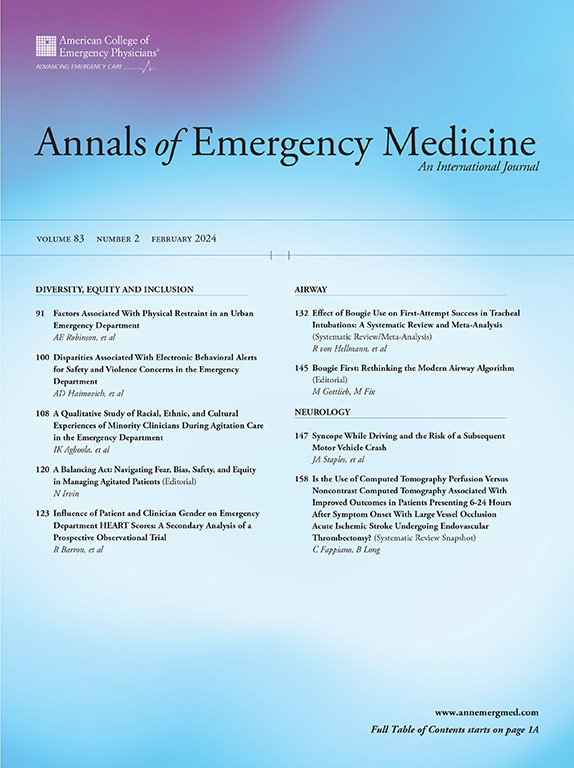常住医师、受雇旅行医师和本地急诊医师的生产力和临床护理差异。
IF 5
1区 医学
Q1 EMERGENCY MEDICINE
引用次数: 0
摘要
研究目的急诊科(ED)人员短缺增加了对当地医生(locums)的依赖。我们比较了固定员工、受雇旅行者和临时医生在一个地点的前100个轮班期间的生产力、质量、利用率和临床实践措施。方法:我们进行了一项回顾性队列研究,使用线性回归比较了三种医生类型的结果,使用的数据来自2021年1月至2023年7月的国家ED组,来自使用旅行者或locums的站点。协变量包括患者特征、病例组合、急诊科数量和住院、日期和时间、之前在该地点轮班的次数、前30天在该地点轮班的次数以及地点固定效应。结果我们纳入了126个地点的1195名工作人员、37名旅行者和266名当地人的67,400个班次。工作人员和旅行者的平均每小时患者数相似(1.8 vs 1.8,校正系数[ß] 0.003, 95%可信区间[CI] -0.051至0.057),但工作人员与游客的平均每小时患者数略高(1.8 vs 1.7, ß 0.101, 95% CI 0.052至0.150)。每位患者的平均相对价值单位在工作人员中比在医生中更高(4.7 vs 4.4, ß 0.127, 95% CI 0.097至0.157)。我们观察到在72小时的复诊、入院或转院、出院胸痛患者的凝血检查、晕厥的脑计算机断层扫描(CT)订单、d -二聚体与CT肺血管造影、总体CT订单、ED住院时间或出院阿片类药物处方方面没有统计学差异。结论实习生在前100个班次的工作效率低于普通员工。各组之间的其他指标相似。本文章由计算机程序翻译,如有差异,请以英文原文为准。
Differences in Productivity and Clinical Care Between Permanent Staff, Employed Travel, and Locum Tenens Emergency Physicians.
STUDY OBJECTIVE
Emergency department (ED) staffing shortages have increased reliance on locum tenens physicians (locums). We compared productivity, quality, utilization, and clinical practice measures between permanent staff, employed travelers, and locums during their first 100 shifts at a site.
METHODS
We performed a retrospective cohort study comparing outcomes between the 3 physician types with linear regression, using data from a national ED group from January 2021 to July 2023 from sites that used travelers or locums. Covariates included patient characteristics, case mix, ED volume and boarding, date and time, count of prior shifts at the site, shifts in the prior 30 days at the site, and site-fixed effects.
RESULTS
We included 67,400 shifts worked by 1,195 staff, 37 travelers, and 266 locums at 126 sites. Mean patients per hour was similar between staff and travelers (1.8 vs 1.8, adjusted coefficient [ß] 0.003, 95% confidence interval [CI] -0.051 to 0.057) but modestly higher for staff vs locums (1.8 vs 1.7, ß 0.101, 95% CI 0.052 to 0.150). Mean relative value units per patient was higher for staff vs locums (4.7 vs 4.4, ß 0.127, 95% CI 0.097 to 0.157). We observed no statistical differences in 72-hour returns, admissions or transfers, coagulation testing among discharged chest pain patients, brain computed tomography (CT) orders for syncope, D-dimer with CT pulmonary angiogram, overall CT orders, ED length of stay, or discharge opioid prescriptions.
CONCLUSION
Locums were less productive than staff during their first 100 shifts. Other measures were similar among groups.
求助全文
通过发布文献求助,成功后即可免费获取论文全文。
去求助
来源期刊

Annals of emergency medicine
医学-急救医学
CiteScore
8.30
自引率
4.80%
发文量
819
审稿时长
20 days
期刊介绍:
Annals of Emergency Medicine, the official journal of the American College of Emergency Physicians, is an international, peer-reviewed journal dedicated to improving the quality of care by publishing the highest quality science for emergency medicine and related medical specialties. Annals publishes original research, clinical reports, opinion, and educational information related to the practice, teaching, and research of emergency medicine. In addition to general emergency medicine topics, Annals regularly publishes articles on out-of-hospital emergency medical services, pediatric emergency medicine, injury and disease prevention, health policy and ethics, disaster management, toxicology, and related topics.
 求助内容:
求助内容: 应助结果提醒方式:
应助结果提醒方式:


